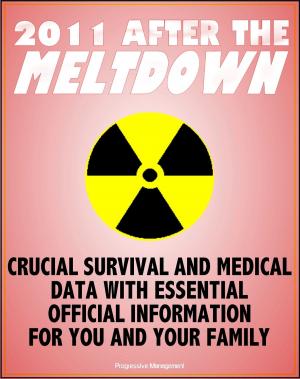CRE Carbapenem-Resistant Enterobacteriaceae Sourcebook: Clinical Data for Patients, Physicians, and Health Care Institutions on the New Threat of Untreatable "Superbug" Bacteria
Nonfiction, Health & Well Being, Health, Ailments & Diseases, Contagious| Author: | Progressive Management | ISBN: | 9781301160976 |
| Publisher: | Progressive Management | Publication: | March 7, 2013 |
| Imprint: | Smashwords Edition | Language: | English |
| Author: | Progressive Management |
| ISBN: | 9781301160976 |
| Publisher: | Progressive Management |
| Publication: | March 7, 2013 |
| Imprint: | Smashwords Edition |
| Language: | English |
This comprehensive ebook provides authoritative information and practical advice from the nation's health experts at the CDC on the new threat posed by Carbapenem-resistant Enterobacteriaceae. CRE are untreatable or difficult-to-treat multidrug-resistant organisms that are emerging in the United States. Guidelines and documents on the CRE threat and related issues of multidrug-resistant bacteria are compiled in this convenient collection. There is detailed and specific advice and information for patients, clinicians, hospitals, and other health care providers.
Contents include: CDC Guidance Documents and Updates through March 2013 * Carbapenem-resistant Enterobacteriaceae (CRE) Infection Reports * Get Smart for Healthcare * Clinical Studies * Guidance for Control of Carbapenem-resistant Enterobacteriaceae - 2012 CRE Toolkit * Laboratory Protocol * Management of Multidrug-Resistant Organisms In Healthcare Settings, 2006 * Guide to Leading Medical Websites
This edition includes our exclusive Guide to Leading Medical Websites with updated links to 81 of the best sites for medical information, which let you quickly check for updates from the government and the best commercial portals, news sites, reference/textbook/non-commercial portals, and health organizations.
Enterobacteriaceae are a family of bacteria that commonly cause infections in health-care settings as well as in the community. Among Enterobacteriaceae, resistance to broad-spectrum carbapenem antimicrobials has been uncommon. Over the past decade, however, carbapenem-resistant Enterobacteriaceae (CRE) have been recognized in health-care settings as a cause of difficult-to-treat infections associated with high mortality. CRE infections are most commonly seen in people with exposure to healthcare settings like hospitals and long-term care facilities, such as skilled nursing facilities, and long-term acute care hospitals. In healthcare settings, CRE infections occur among sick patients who are receiving treatment for other conditions. Patients whose care requires devices like ventilators (breathing machines), urinary (bladder) catheters, or intravenous (vein) catheters, and patients who are taking long courses of certain antibiotics are among those at risk for CRE infections.
Some CRE bacteria have become resistant to almost all available antibiotics and can be deadly—one report cites they can contribute to death in up to 50% of patients who become infected.
Of the 37 unusual forms of CRE that have been reported in the United States, the last 15 have been reported since July, 2012. This increase highlights the need for U.S. healthcare providers to act aggressively to prevent the emergence and spread of these unusual CRE organisms. Because the vast majority of these unusual organisms were isolated from patients who received overnight medical treatment outside of the United States, additional measures described in this HAN advisory are now recommended to be taken when such patients are hospitalized in the United States.
Action is needed now to stop these deadly infections. CRE germs have found ways to beat antibiotics. CRE infections are caused by a family of germs that are a normal part of a person's healthy digestive system. These germs can cause infections when they get into the bladder, blood, or other areas where germs don't belong. Some of these germs have become resistant to all or almost all antibiotics, including last-resort drugs called carbapenems. These resistant germs are called CRE. Almost all CRE infections happen to patients receiving serious medical care. CRE infections are hard to treat, and in some cases, untreatable. CRE kill up to half of patients who get bloodstream infections from them. In addition to spreading among people, CRE easily spread their antibiotic resistance to other kinds of germs, making those potentially untreatable as well. CRE infections are spreading, and urgent action is needed to stop them.
This comprehensive ebook provides authoritative information and practical advice from the nation's health experts at the CDC on the new threat posed by Carbapenem-resistant Enterobacteriaceae. CRE are untreatable or difficult-to-treat multidrug-resistant organisms that are emerging in the United States. Guidelines and documents on the CRE threat and related issues of multidrug-resistant bacteria are compiled in this convenient collection. There is detailed and specific advice and information for patients, clinicians, hospitals, and other health care providers.
Contents include: CDC Guidance Documents and Updates through March 2013 * Carbapenem-resistant Enterobacteriaceae (CRE) Infection Reports * Get Smart for Healthcare * Clinical Studies * Guidance for Control of Carbapenem-resistant Enterobacteriaceae - 2012 CRE Toolkit * Laboratory Protocol * Management of Multidrug-Resistant Organisms In Healthcare Settings, 2006 * Guide to Leading Medical Websites
This edition includes our exclusive Guide to Leading Medical Websites with updated links to 81 of the best sites for medical information, which let you quickly check for updates from the government and the best commercial portals, news sites, reference/textbook/non-commercial portals, and health organizations.
Enterobacteriaceae are a family of bacteria that commonly cause infections in health-care settings as well as in the community. Among Enterobacteriaceae, resistance to broad-spectrum carbapenem antimicrobials has been uncommon. Over the past decade, however, carbapenem-resistant Enterobacteriaceae (CRE) have been recognized in health-care settings as a cause of difficult-to-treat infections associated with high mortality. CRE infections are most commonly seen in people with exposure to healthcare settings like hospitals and long-term care facilities, such as skilled nursing facilities, and long-term acute care hospitals. In healthcare settings, CRE infections occur among sick patients who are receiving treatment for other conditions. Patients whose care requires devices like ventilators (breathing machines), urinary (bladder) catheters, or intravenous (vein) catheters, and patients who are taking long courses of certain antibiotics are among those at risk for CRE infections.
Some CRE bacteria have become resistant to almost all available antibiotics and can be deadly—one report cites they can contribute to death in up to 50% of patients who become infected.
Of the 37 unusual forms of CRE that have been reported in the United States, the last 15 have been reported since July, 2012. This increase highlights the need for U.S. healthcare providers to act aggressively to prevent the emergence and spread of these unusual CRE organisms. Because the vast majority of these unusual organisms were isolated from patients who received overnight medical treatment outside of the United States, additional measures described in this HAN advisory are now recommended to be taken when such patients are hospitalized in the United States.
Action is needed now to stop these deadly infections. CRE germs have found ways to beat antibiotics. CRE infections are caused by a family of germs that are a normal part of a person's healthy digestive system. These germs can cause infections when they get into the bladder, blood, or other areas where germs don't belong. Some of these germs have become resistant to all or almost all antibiotics, including last-resort drugs called carbapenems. These resistant germs are called CRE. Almost all CRE infections happen to patients receiving serious medical care. CRE infections are hard to treat, and in some cases, untreatable. CRE kill up to half of patients who get bloodstream infections from them. In addition to spreading among people, CRE easily spread their antibiotic resistance to other kinds of germs, making those potentially untreatable as well. CRE infections are spreading, and urgent action is needed to stop them.















